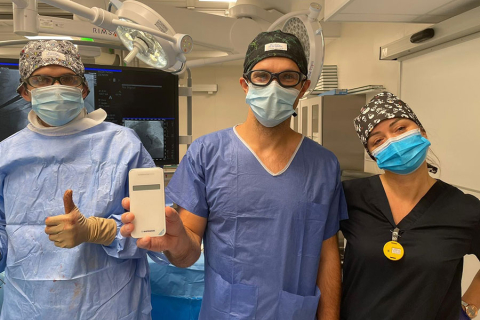Epidemiological data indicate that heart failure is responsible for approximately 10% of deaths in Poland. One in four patients hospitalised for heart failure are readmitted to hospital within one month of discharge. – One of the goals of treating this disease entity is to bring about the maximum circulatory equalisation of the patient enabling stable functioning at home, says Professor Marcin Grabowski, Head of the First Chair and Department of Cardiology at the UCK MUW. That is why MUW specialists have been looking for modern methods to monitor the condition of patients outside the clinic. The solution turned out to be HeartInsight.
The HeartInsight algorithm is used in cardioverter-defibrillators with resynchronisation function. Such devices stimulate the right and left ventricles simultaneously. The innovation of the algorithm is based on the analysis of clinical parameters measured daily, such as mean heart function, atrial arrhythmia load, number of extra ventricular beats, heart rate variability or transthoracic resistance. The data collected by HeartInsight is sent to the UCK MUW’s 1st Department and Chair of Cardiology automatically – via a transmitter that the patient receives for home use. In the event of a significant adverse change in the indicators, the system also sends an alert to the doctor suggesting the risk of a possible exacerbation of heart failure.
The procedures for implantation of the implantable cardioverter-defibrillator equipped with the algorithm were carried out by a team consisting of Dr Marcin Michalak, Łukasz Januszkiewicz, Phd, Krzysztof Ozierański, PhD, nursing assistants – Dorota Dużyńska and Dorota Świątek, electroradiology technician Katarzyna Zawiła. The telemonitoring system is supervised by Doctor Jakub Kosma Rokicki.
Previous studies indicate that the HeartInsight algorithm has a sensitivity of approximately 66% in predicting worsening symptoms requiring hospital admission. On average, it is about 42 days before the episode. As Professor Grabowski, with the HeartInsight system, doctors gain valuable time to implement a treatment change that has the potential to alter the course of the disease in such a way that the patient can stay at home. One patient who was implanted with the innovative device has already been hospitalised several times this year for heart failure. – It is hoped that optimising therapy based on a remote monitoring system will allow the patient to avoid further episodes of this kind – says Professor Grabowski.
According to data collected in large studies in the long term, hospital admission not only does not help patients with heart failure, but actually reduces their chances of survival. The aim of centres managing patients with this type of diagnosis should therefore be to optimise treatment in the outpatient setting. One way to improve the prognosis of selected patient populations with impaired myocardial function is to use resynchronisation pacing to restore near physiological cardiac activation.
Clinical trials conducted over the past two decades have assessed the predictive performance of these parameters. The multi-parametric patient assessment system implemented at the Department of Cardiology of the Warsaw Medical University was based on the results of the SELENEHF study. The systematic and prospective nature of the study allowed the selection of those indicators whose occurrence significantly altered the natural history of the disease course. The HeartInsight algorithm uses a number of novel parameters that have not previously been included in published work. The novel inclusion of measurable electrophysiological elements that were known to cardiologists as clinical parameters of circulatory deterioration, such as the number of premature ventricular beats or heart rate variability during daytime and night-time activity, allowed a clinical evaluation 42 to 62 days ahead of hospital admission with little workload for medical professionals involved in the remote monitoring of patients with implanted cardiac electrograms. Adequate interpretation of the data received from the device, together with the weighting of these findings, allows an early response to subclinical features indicative of deteriorating myocardial performance and, therefore, increases the possibility of intervention to prevent hospitalisation.
The use of device telemonitoring implemented at the Clinic fits not only with current clinical needs, but also with the strategy of organising and reimbursing medical services in Poland. On the second of December this year, the Minister of Health signed an amendment to the regulation on guaranteed services in the field of outpatient specialised care - with regard to telemonitoring. The regulation will enter into force 14 days after its publication.
Innovative algorithm monitors heart function in patients with severe heart failure
HeartInsight analyses parameters that indicate an exacerbation of heart failure. And when its risk appears in a patient, the algorithm sends an appropriate alert to the doctor. This innovative solution was the first in Poland to be used by specialists from the First Chair and Department of Cardiology of the UCK MUW in two patients suffering from a severe form of this condition.
